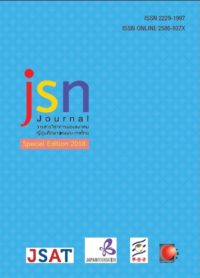A Study of Repeated Words in Japanese Idioms
Main Article Content
Abstract
This research aims to 1) study the existence of repetition which exist in “SAMNUAN” (Thai Idiom) of Thai language that actually also exists in “KANYOOKU” (Japanese Idiom) of Japanese Language or not. 2) To study the figure of the existence of repetition which appears in the “KANYOOKU” of Japanese. The research was conducted in the first step through studying of the pattern of repetition found in the “SAMNUAN” that Sanga (1995) was presented in “Thai idioms”. Then, set the boundary of the experimental group as the study goal. It is 4,049 expressions of “KANYOOKU” that is a collection from 2 good reputed and popular “KANYOOKU” dictionaries are widely accepted for the study of “KANYOOKU” in Japan. That is the『日本語の慣用句辞典』dictionary of Ootani, Yonekawa (2008) and the『故事ことわざ・慣用句辞典』dictionary of Kuramochi, Sakata (2008). In the final step, make the conclusion of the figure of “KANYOOKU” with the use of repetition and summary of results. The results of this research show that in the 4,049 expressions of “KANYOOKU”, there are expressions of “KANYOOKU” that do not have the use of repetition of up to 3,909 expressions, or 96.54 percent. And there is only a few of expressions of “KANYOOKU” just 140 expressions, which is 3.46 percent, have the use of repetition, but not enough to say that it is a dominant feature of “KANYOOKU”.
Article Details
Section
บทความวิจัยและบทความวิชาการ
ข้อความและข้อคิดเห็นต่างๆ ในบทความเป็นของผู้เขียนบทความนั้นๆ ไม่ใช่ความเห็นของกองบรรณาธิการหรือของวารสาร jsn Journal
References
สง่า กาญจนาคพันธุ์. (1995). สํานวนไทย.กรุงเทพฯ: สํานักพิมพ์กรุงเทพรวมสาส์น.
ประภาศรี สีหอําไพ. (1995). วัฒนธรรมทางภาษา. กรุงเทพฯ: สํานักพิมพ์จุฬาลงกรณ์มหาวิทยาลัย.
呉琳[Wu Len] (2016). 「日本語の慣用句に関する研究の概観」『日中語彙研究』 6号 愛知大学中日大辞典編纂所, pp. 87-105.
チャンタラチャムノング セックサン (2014). 「タイ語の「samnuan」の定義について―日本語の慣用句との対応から―」『国語国文学』56 号別府大学, pp.1-10.
宮地裕 (1997).「慣用句と連語成句」『日本語教育』33 号日本語教育学会, pp. 73-81.
宮地裕 (1982).「慣用句解説」『慣用句の意味用法』明治書院, pp. 237-265.
宮地裕 (1999).「慣用句の表現」『敬語・慣用句表現論―現代語の文法と表現の研(2)』文化庁 明治書院, pp. 213-339.
森田良行 (1985).「動詞慣用句」『日本語学』1月号 vol. 4明治書院, pp.37-44.
大谷伊都子・米川明彦 (2008). 『日本語慣用句辞典』三省堂.
倉持保男・阪田雪子 (2010).『故事ことわざ・慣用句辞典』東京堂.


